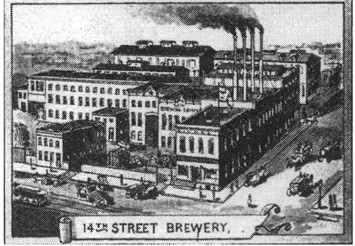14th Street Brewery; Star Brewery
Introduction
Text-to-speech Audio
Now home to Main Street Theatre, this was the site of one of the largest breweries in Kansas City in the 1870s and 1880s. F.H. Kump arrived in Kansas City in 1859 and entered the soda manufacturing business with a small plant here in 1867. Kump used his equipment to bottle beer for other brewers, and within two years, the operation expanded to brewing and bottling his own beer. By 1884, the business had expanded and produced around 12,000 barrels per year when F.H. Kumps Star Ale Brewery was sold to Fred Heim and his family. Heim would later build one of the largest breweries in the city in the East Bottoms. This location was known by several names during Heim's tenure as owner, including the Bavarian Brewing Company. The theater was completed in 1921 and included several unique features, such as tunnels to the adjacent President Hotel that were utilized mainly by traveling actors who prepared their costumes and makeup in their rooms. The theater also featured a nursery for children whose parents were attending the show and a sub-basement with cages for animals such as elephants that could be lifted to the stage.
Images
This drawing of the 14th Street Brewery from the 1870s exaggerates its size but is the only known image

Backstory and Context
Text-to-speech Audio
In 1850, Kansas City had less than 6,000 people and had two breweries. The population boom in the next decades attracts other brewers and existing breweries. Shortly after purchasing the brewery at this location, Heim's beer won national attention. In 1888, Heim built a five-story brick brewing complex in the East Bottoms, and thirteen years later, he built the bottling plant that is now home to the J. Rieger distillery, a modern business named in honor of a former Kansas City distillery that began in the West Bottoms in 1887. With its emphasis on history that includes numerous exhibits, Rieger also produces a modern version of Heim's lager that can be purchased on-site and is known as Heim Bier.
In the mid-1880s, Heim and his sons acquired a former sugar mill refinery at the intersection of Agnes Avenue and Montgall to expand their operations. The family built a substantial five-story malt house the following year along with numerous other facilities in what became a vast brewery complex. The Heim family also built a streetcar line and Electric Park in 1899, an amusement park next to the brewery that was known for its display of over 100,000 electric lights along with rides and a theater, as well as a beer garden that served beer directly from the neighboring brewery. The streetcar line led to hundreds of families moving to the East Bottoms and Heim built a fire station that later became part of the city system. In 1907, the company moved Electric Park to 46th and Paseo, where it would earn the nickname "Kansas City's Coney Island." They sold their rail line to the city's largest operator, the Metropolitan Street Railway Company.
Sources
Euston, Diane. "Saving Imperial Brewery, Kansas City's Only Pre-Prohibition Brewery Standing." Martin City Telegraph July 20th, 2022.
Postcard of the Main Street Theater, Mrs. Sam Ray Postcard Collection (SC58), Kansas City Public Library, https://kchistory.org/image/main-street-theater accessed 10/14/24
Diane Euston, "The Heim Brewer Legacy Lives on in Kansas City," Martin City Telegraph, May 9, 2022 https://martincitytelegraph.com/2022/05/09/the-heim-brewery-legacy-lives-on-in-kansas-city/
Missouri Department of Natural Resources, "Ferd. Heim Brewing Company Bottling Plant," National Register of Historic Places Nomination Form, 2016.
H. James Maxwell and Bob Sullivan. Hometown Beer - A History of Kansas City's Breweries. Kansas City, MO. Omega Innovative Marketing, 1999.
Ferd. Heim Brewing Company Bottling Plant National Register Nomination Form
